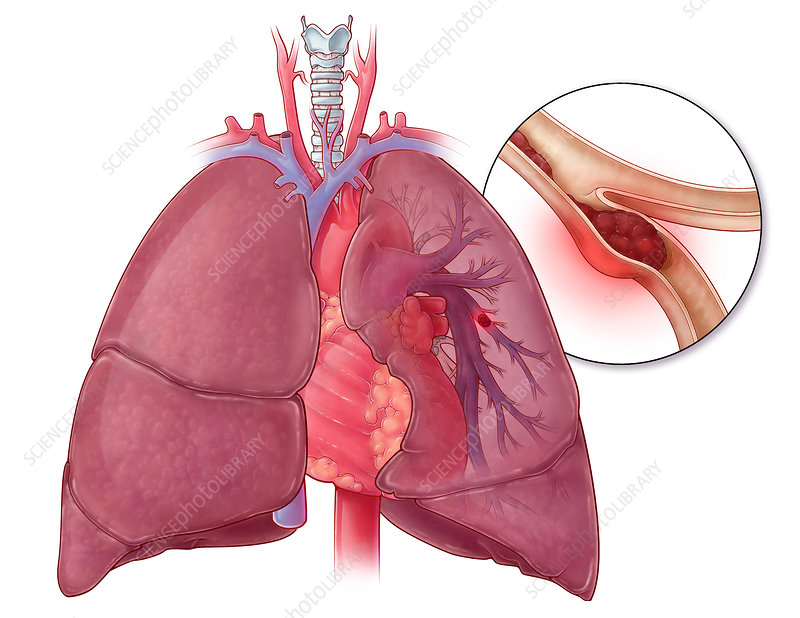Which patient is most likely experiencing a pulmonary embolism (PE)?
A 40-year-old woman who came into the ER with a swollen, painful calf and now complains of chest pains and having trouble breathing, with tachycardia and tachypnea.
A 60-year-old man who is tired and has been in the med-surg unit for 3 days with AKI after taking IV antibiotics.
A 30-year-old man with a history of smoking and a sedentary lifestyle who had an appendectomy 1 day ago and is refusing to ambulate or wear compression stockings.
A 55-year-old woman who came into the ER with chest pains, shortness of breath, nausea, tachypnea, and radiating jaw pain.
The Correct Answer is A
Choice A reason : The symptoms described for the 40-year-old woman align closely with the clinical presentation of a pulmonary embolism. Swelling and pain in the calf may indicate deep vein thrombosis (DVT), which can lead to PE. The presence of chest pain, difficulty breathing, rapid heart rate (tachycardia), and rapid breathing (tachypnea) are hallmark signs of PE³⁴.
Choice B reason : While the 60-year-old man is experiencing fatigue, which can be a symptom of many conditions, there is no direct indication of PE. Acute kidney injury (AKI) after IV antibiotics suggests a different pathophysiology unrelated to PE.
Choice C reason : The 30-year-old man's refusal to ambulate or wear compression stockings after surgery increases his risk for DVT and subsequently PE; however, he does not currently exhibit symptoms that are as indicative of PE as the 40-year-old woman.
Choice D reason : The 55-year-old woman's symptoms could suggest a cardiac event, such as a heart attack, especially with the radiating jaw pain. While PE can present with similar symptoms, the radiating pain is more characteristic of cardiac issues³.

Nursing Test Bank
Naxlex Comprehensive Predictor Exams
Related Questions
Correct Answer is B
Explanation
Choice A reason : Fibromyalgia can indeed be associated with migraine headaches. Many individuals with fibromyalgia report experiencing headaches, and migraines are a common comorbidity. The exact link between fibromyalgia and migraines is not fully understood, but it is believed that the same abnormalities in neurotransmitter levels that contribute to fibromyalgia pain may also predispose individuals to migraines¹².
Choice B reason : The statement "Fibromyalgia causes joint inflammation" is incorrect and indicates a need for further teaching. Fibromyalgia does not cause inflammation within the joints. It is characterized by widespread musculoskeletal pain, fatigue, and tenderness in specific areas, but it does not involve the type of joint inflammation seen in conditions like rheumatoid arthritis¹². This misconception may arise because the symptoms can be similar to those of arthritic conditions, but the underlying mechanisms are different.
Choice C reason : Fibromyalgia may indeed cause chest pain, which is often referred to as costochondritis when it involves the cartilage of the rib cage. This chest pain can mimic that of a heart attack or other heart conditions, but it is actually a common symptom of fibromyalgia and is related to the tender points in the chest area¹².
Choice D reason : It is true that fibromyalgia symptoms may worsen depending on the weather. Many patients report that their symptoms flare up in response to changes in weather, temperature, and humidity. However, the reasons for this sensitivity are not entirely clear, and research on the subject has produced mixed results¹².
Correct Answer is B
Explanation
Choice A reason :While consulting with the healthcare provider is important, immediate action is necessary to prevent harm. Waiting for a prescription may delay intervention.
Choice B reason : When a patient frequently attempts to remove their intravenous (IV) catheter, it's essential to address the behavior promptly to prevent potential complications such as catheter dislodgement, infection, or injury. The most appropriate initial response is to cover the catheter to reduce the patient's awareness and access, thereby decreasing the likelihood of tampering.
Choice C reason : Providing more stimulation could be counterproductive if the client is already agitated or confused. The nurse should assess the client's needs and environment to determine the appropriate level of stimulation.
Choice D reason : Waiting without taking action is not advisable as the client may harm themselves by removing the IV catheter. Immediate intervention is required to ensure the client's safety.
Whether you are a student looking to ace your exams or a practicing nurse seeking to enhance your expertise , our nursing education contents will empower you with the confidence and competence to make a difference in the lives of patients and become a respected leader in the healthcare field.
Visit Naxlex, invest in your future and unlock endless possibilities with our unparalleled nursing education contents today
Report Wrong Answer on the Current Question
Do you disagree with the answer? If yes, what is your expected answer? Explain.
Kindly be descriptive with the issue you are facing.
